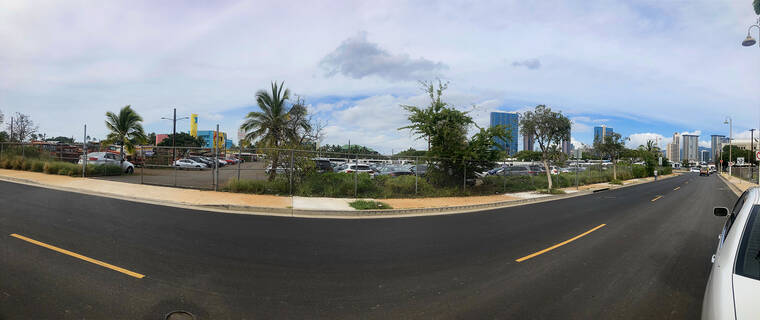The gulf separating the positions held by the Office of Hawaiian Affairs and the state House over the development of OHA land at Kakaako Makai still appears impassable.
There is hope, however, that in this case things aren’t as they appear at the moment, that a conversation has begun that could lead to a compromise that is fair and beneficial to Native Hawaiians and the Hawaii community at large.
The dispute centers on the 31 acres of land makai of Ala Moana Boulevard that in 2012 were deeded to OHA in settlement of past deficits in state payments for revenues from ceded lands. These were properties ceded to the U.S., and ultimately to the state, following the annexation of the Hawaiian government and crown lands.
The barrier left unresolved in that 2012 settlement is that in 2006, state lawmakers had restricted the makai portion of the Kakaako redevelopment zone from any residential use.
In the more than a decade since the settlement deal was inked, OHA has tried repeatedly to get that restriction lifted, arguing that the land had been reappraised at far below the $200 million value asserted in the 2012 pact.
FTI Consulting, hired to do the reappraisal, set the 2023 value at $43.6 million, taking the residential restriction into account.
Squaring that discrepancy was the idea behind Senate Bill 736, which passed on a full Senate vote but which House leadership decided not to advance further.
State Rep. Scott Saiki, who represents the area and is House speaker, earlier in the legislative session had floated the idea of a negotiated agreement to make OHA whole. Then last week, he released a proposed compromise that could be incorporated as revisions to Senate Bill 1235, which aimed to create a public land trust working group. Under the proposal:
>> The state would pay OHA $100 million and provide $65 million to fix damage to a wharf area on part of the agency’s property.
>> In return OHA would agree to a permanent easement prohibiting residential development and limiting building height and density on its makai acreage between Kewalo Harbor and Honolulu Harbor.
>> Further, the proposal included an annual increase in future ceded-land revenue payments to OHA. On July 1, 2024, it would rise from $21.5 million to $25 million and increase annually thereafter, using a formula based on the consumer price index, excluding energy and food, for urban Hawaii.
On Thursday, the OHA Board of Trustees voted to reject the proposal, still clearly adhering to its current plan for the development, now called Hakuone. In particular, the board found the aggregate amount of the settlement still did not compensate for the loss of residential development rights.
In a prepared statement, OHA Chair Carmen Hulu Lindsey said the board was not asking for special treatment beyond what was accorded private developers building high-rise residential towers mauka of Ala Moana Boulevard.
This may be true, but the two sides of Ala Moana are not the same, and require different land-use considerations. High-rise towers on the makai side, being that much closer to the shoreline, would be difficult to accommodate in an era of sea-level rise, much of it well within the tsunami evacuation zone.
Since taking over the makai lands in 2012, OHA could have made more of a good-faith effort to monetize the property. The lack of a real-estate strategy or land-development policies drew criticism in a state auditor’s report last month. The fact that the acreage remains unimproved from its current deteriorated state is partly the result of the board’s lack of action.
That said, the time may have come to take another look at what would help to ensure the successful development of the Hakuone parcels.
In a word: activation. And perhaps, a limited amount of low-rise housing could inject part of what a vibrant, attractive community would need — helping to sustain businesses, enliven the existing and new public spaces, and to reverse the district’s deterioration.
There has been opposition to residential development on the makai section — including concerns aired by the Honolulu Star-Advertiser editorial board. These have been concerns specifically focused on the pressures for high-rise development that could constrain public access to the shoreline.
Those who are opposed to development more generally must know: OHA already has the right to erect commercial buildings that could house a range of retail and entertainment attractions. The record of success for such projects that are developed in isolation from a larger community is spotty. As witnessed in Kakaako Mauka, the expansion of the residential element has helped to support the commercial side as well.
A successful, vital waterfront district is something that all should want to see for Honolulu.
It’s encouraging to see that, despite the current standoff, both sides have expressed expectations of more serious talks. Even if reaching a final settlement this legislative session is too high a hurdle, finding a middle path should be possible. Let the conversations continue toward that end.

CRAIG T. KOJIMA / CKOJIMA@ STARADVERTISER.COM
Original can be found at: https://www.staradvertiser.com/2023/04/09/editorial/our-view/editorial-find-fair-deal-for-kakaako-makai/
